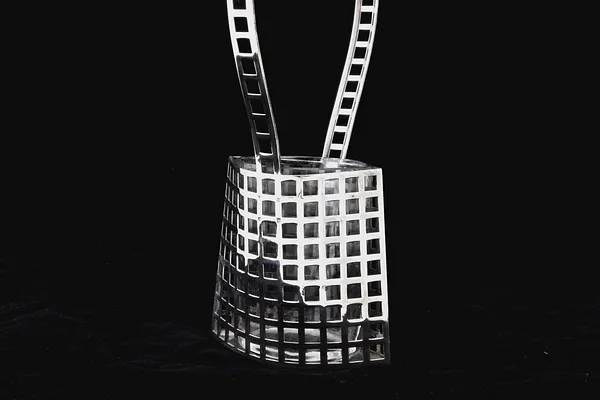If AI thinks and produces, what's left for craft?
Hello! This is the I MILLE newsletter. It's called Forward because from here we try to look ahead (and also because if you like what we write, you can forward it to someone you like). Like you, over 1,700 other people working in the world of communication, marketing and digital read I MILLE Forward, and over 26,000 follow what we have to say on LinkedIn and Instagram.
Wiener Werkstätte silver basket by Joseff Hoffman. 1905.
The Arts & Crafts movement emerged in England during the second half of the 1800s as a reaction to growing industrialization - an attempt to reassert craftsmanship against industrial coldness.
Artists who joined this movement produced carpets, textiles, furniture, metalwork, driven by an anti-industrial philosophy and strong collaborative spirit. Yet Arts & Crafts would lay the groundwork for modern design principles through eclectic, airy production that was far more progressive than the industry of its time. The movement also established the foundations for the Wiener Werkstätte, which in early 1900s Vienna became the first true design movement in contemporary history.
What does any of this have to do with Generative Artificial Intelligence?
Today, Gen AI - instructed through precise prompts and enriched with appropriate references - can create worlds unimaginable just years ago. Can we call it artistic production when a machine receives specific instructions but generates outputs that remain, even today, not entirely controllable? Absolutely. Since art is expression, and if this process is partially -or even completely - AI-based, we can't exclude it from being artistic work.
We won't dwell too much on Art, partly because defining what is or isn't Art today is an incredibly complex undertaking. However, Generative AI still lacks physicality - Craft. The ability to produce physical objects that combine different materials or use even basic crafting techniques like cutting paper, gluing, and so forth. Though significant progress is being made in this direction.
BOLON at Fuorisalone Milan 2025. Installation by JoAnn Tan & Luca Nichetto.
Generative design for creating physical objects represents one of AI's most innovative applications. The main advantages today center on material efficiency - reducing weight by up to 70% while maintaining equivalent performance. We see innovative structures with forms and geometries that human designers would struggle to conceive. Mass customization means rapid adaptation of designs to specific requirements. Finally, optimization for additive manufacturing creates designs specifically tailored to 3D printing capabilities.
But there's something humanoids or robots probably can't execute, at least not yet: the ability to continuously adapt and modify their craft skills based on contingent situations. It's a condition artisans know intimately - that quality born from experience, from making countless mistakes, correcting them, failing again, and finally grasping the "tricks of the trade" that can be unique and exclusive, even among professionals in the same field.
We're likely witnessing a scenario where every industrially produced object can be conceived, designed, and obviously manufactured with AI assistance under human supervision. Meanwhile, humans might specialize in crafting, because creating humanoids or robots capable of learning through trial and error would be prohibitively expensive and pointless. Machines, supervised by people, will think and mass-produce objects. The human species will specialize in thinking and producing unique pieces.
We might therefore see a polarized landscape: on one side, industrial production increasingly optimized by AI; on the other, a renaissance of premium human craftsmanship, with growing value distinction between these two realms.
This polarization could create new economic opportunities while potentially widening social gaps.
On one hand, there are promising opportunities:
1. Emerging niche markets: The perceived value of human craftsmanship could skyrocket, creating flourishing economic ecosystems around specialized manual skills.
2. Production democratization: AI might make small-scale production more accessible, allowing small entrepreneurs to compete with efficiency rivaling major corporations.
3. Innovative hybridization: Fascinating models could emerge where AI supports artisans without replacing them, amplifying human capabilities.
However, inequality risks loom:
1. Skills divide: Those unable to adapt to the new technological paradigm or lacking distinctive craft skills could face marginalization.
2. Economic concentration: If AI optimization requires substantial investments, we might see further concentration of economic power among few players.
3. Access inequality: Artisanal products could become luxury goods accessible only to a minority, while the majority relies on standardized products.
The outcome will largely depend on the policies we adopt: if we promote democratic access to AI technologies, continuous training, and recognition of diverse forms of work, we could achieve a future where this polarization becomes complementarity rather than division.
Isaak at Fuorisalone Milan 2025. A vision by Ditroit.
While the Arts & Crafts movement arose to oppose industrialization and emerging technological revolution in industrial design, AI's new frontiers confront us with complete human-machine integration.
The etymology of Artifact (manufactured object) is this: "Artificial production, anything made or modified by human art." In the future, we'll probably need to speak of AI-Artifacts: "Artificial production, anything made or modified by Artificial Intelligence & Human Art."
